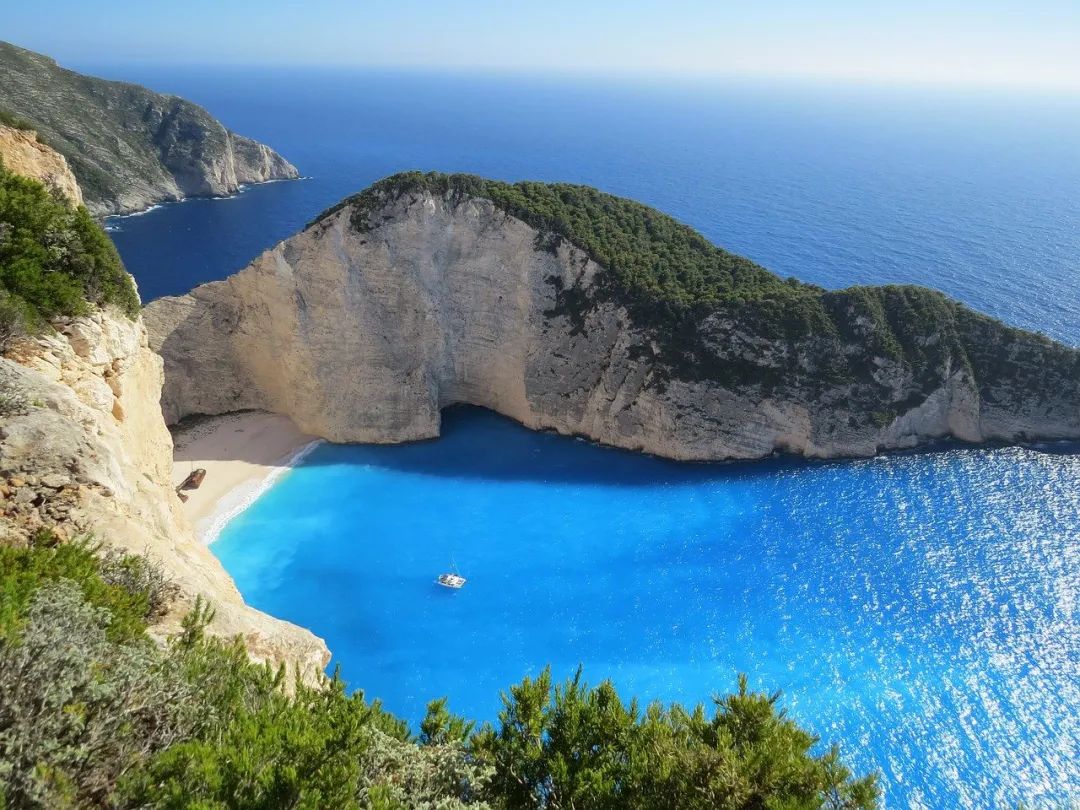卡納克巨石陣,難解的歷史之謎

瀕臨大西洋的卡納克是位于法國布列塔尼半島一個(gè)神秘的小鎮(zhèn)。它的郊外散布著一片片整齊排列的石陣,在長(zhǎng)達(dá)8千米的范圍內(nèi)到處是林立的巨石,這就是著名的卡納克石陣,被英國考古學(xué)家海丁翰教授稱為“比金字塔更神秘”的石柱群。
Reminiscent of Stonehenge[1], upright stones dot the French landscape of the area we know as ancient Brittany. Surrounding the tiny village of Carnac, France, they became known as the Carnac stones. More than 3,000 stones, standing in defined rows, obviously are not the product of natural phenomena. In fact, scientists have determined that they were cut from rock found in the area and erected[2] by humans between 4,500 and 2,000 B.C.
In recent centuries, many of the sites have been neglected[3], with reports of the stones being used as sheep shelters, chicken sheds or even ovens. Even more commonly, stones have been removed to make way for roads, or as building materials. The continuing management of the sites remains a controversial topic.
Major archaeological[4] interest in the stone rows only happened in the latter half of the 20th century. These archaeologists originally believed that rather than a series of stone rows, there was in origin just one major stone row, covering a distance of more than eight kilometres. Soon, research revealed that this “single stone row” theory did not hold water[5]; it seemed that there were mainly three stone rows, each containing approximately 1,000 stones.
One such concentration of stones can be found near Erdeven; the other concentration of stones stands back to the north of Carnac. The most western is that of Menec, where there are 1,099 standing stones in 12 rows. One stone towers above[6] all others, and is thus labelled “the giant”, measuring 3.70 metres. Most of the stones are, however, relatively small, in comparison to the stone row of Kermario, to the east of the row of Menec. Kermario counts 1,029 stones, distributed in ten rows. The field measures 1,120 metres, showing that the stones are roughly one metre apart. This field has the most gigantic[7] stones, and is continued in the field of Kerlescan, where there are 594 stones, in 13 rows and over 880 metres.
All three fields are constructed on the same principle: the tallest stones are located on the western side; the western side is also situated on higher ground than its eastern counterpart. The smaller stones on the eastern side are also at smaller intervals from each other.
Archaeologists have excluded the possibility that these are graves. Neither did they serve a military purpose, though the American soldiers, during the Second World War, did mistake the stone rows for a German defence line. According to the legend, a French soldier who was aware of the situation had to intervene, as otherwise the stone rows would have become the target of intensive bombing raids.
Excluding funerary and military purposes, archaeologists conclude that the only purpose could have been religious. Many researchers agree that the megalithic[8] civilisation worshipped nature, and possibly the sun in particular. Some argue that megalithic complexes are astronomical observatories. But whereas impressive research has been done on this aspect, the most basic aspect of this research time and again reveals a particular focus towards the sun.
Carnac is an ideal location for any solar worshipper. The sun makes an appearance almost every day, as the area is blessed with a micro-climate. Situated at the coast of Brittany, it is located at the site where the Gulf Stream hits the European continent. Carnac is furthermore shielded by a peninsula, known as the Presqu’ile de Quiberon. Carnac is therefore proud of its 2,053 hours of sun per year, which from April results in 7 hours of daily sunshine. That we found a series of impressive stone rows in exactly this location, could therefore suddenly be easily explained. Further evidencefor such a theory can be found in the fact that the micro-climate of the Bay of Quiberon ends to the north of Erdeven—which is where the stone row of Kerzerho is situated. There are no stone rows to the north of this.
Apart from massive stone rows, other impressive stone monuments can be found in the area. This includes one standing stone, which was twenty metres high, weighed in at 340 ton and was moved over a distance of six kilometres. It should come as no surprise that this stone is no longer standing. But this stone does underline the knowledge and technology of a culture that was able to perform such feats.[9] It also underlines that moving and building with large stones was a well-versed[10] knowledge in Western Europe, a thousand years before the ancient Egyptians began to construct their stone monuments along the river Nile.
在法國的古布列塔尼地區(qū),遍布著一片片石柱群,讓人聯(lián)想起英國的史前巨石陣。它們分布在法國一個(gè)名為卡納克的小鎮(zhèn)周圍,被稱為卡納克巨石陣。三千多塊石頭整齊地排列成排,顯然不是自然之力所為。事實(shí)上,科學(xué)家們已考證出,這些石頭是公元前4,500到2,000年,人們從這里的巖石上切削下來并憑人力樹立起來的。
近幾個(gè)世紀(jì)以來,(卡納克的)許多石陣遺址都廢棄了,據(jù)說,許多石頭被用來修建羊圈和雞舍,甚至用來砌爐子。更多時(shí)候,它們因?yàn)樾蘼繁灰谱撸蛘哂米鹘ㄖ牧稀?duì)這些遺址的持續(xù)性管理一直是頗有爭(zhēng)議的話題。
直到20世紀(jì)后半期,考古學(xué)家才開始對(duì)這里的巨石陣產(chǎn)生了興趣。他們起初認(rèn)為這些石頭陣開始并不是由一系列的一排排的石陣組成,最初主要是一排八千多米長(zhǎng)的石陣。然而,研究很快證明,這個(gè)“單排石陣”的說法站不住腳,石陣起初似乎主要有三排,每排由大約一千塊石頭組成。
其中一個(gè)石陣位于埃爾德旺(卡納克地區(qū)的一個(gè)鎮(zhèn))附近,另一個(gè)則在卡納克以北。位于最西部的是莫奈克石陣,共有1,099塊石頭,排成12排。其中一塊比其他的石頭都要高,達(dá)到了3.7米,因此被冠以 “巨人”之名。然而,與位于莫奈克石陣東部的克馬里歐的石陣相比,這里的大部分石頭仍相對(duì)較小。克馬里歐石陣共有1,029塊石頭,排成10排,長(zhǎng)1,120米,各排之間間距約為一米。這個(gè)石陣的石頭塊頭最大,一直延續(xù)到克勒斯坎巨石陣附近,克勒斯坎的巨石陣包括594塊石頭,13排,長(zhǎng)880多米。
這三個(gè)石陣的布陣都基于同一個(gè)原則:西邊的石柱最高,地勢(shì)也是西部較東部高。東邊略小的石塊之間的間隔也比較小。
考古學(xué)家已經(jīng)排除了巨石陣是墓穴的可能性。它們的修建也并非出于軍事目的,不過,在二戰(zhàn)中,美國士兵確實(shí)曾將這些石陣誤認(rèn)為是德國的防御工事。據(jù)傳,如果不是一個(gè)知情的法國士兵加以阻止,恐怕這些石陣已經(jīng)成為炸彈密集轟炸的目標(biāo)了。
既然排除了墓穴和軍用的可能性,考古學(xué)家斷定,它唯一的用途可能就是宗教崇拜。許多研究者都有共識(shí),巨石文明崇拜自然,尤其崇拜太陽。一些人認(rèn)為,巨石陣乃是天文臺(tái)。然而,這方面的大量研究一次又一次地表明巨石陣與太陽有緊密關(guān)聯(lián)。
對(duì)于任何太陽崇拜者來說,卡納克都是一個(gè)理想之所。這里,太陽幾乎每天都會(huì)露面,因?yàn)檫@里具有一種(獨(dú)特的)微氣候。卡納克位于布列塔尼海岸,是墨西哥灣與歐洲大陸的會(huì)合處。它還受到一個(gè)名為“基伯龍”的半島的庇護(hù)。因此,卡納克每年都得以擁有2,053小時(shí)的光照,四月過后每天都有7小時(shí)沐浴在陽光中。而正是在這里,我們發(fā)現(xiàn)了令人震撼的巨石陣,一切突然變得易于解釋了。對(duì)這個(gè)說法還有更多證據(jù),克拉融海灣的微氣候一直延伸到埃爾德旺北部——正是凱爾澤歐巨石陣的所在地。從此往北就再?zèng)]有任何石陣出現(xiàn)了。
除了巨大的石陣外,這個(gè)地區(qū)還發(fā)現(xiàn)其他令人驚嘆的石頭建筑物。其中有一塊矗立的石頭,高20米,重340噸,被移動(dòng)了6,000米的距離。難怪如今這塊石頭已經(jīng)不再直立著了。然而,這塊石頭確實(shí)折射出那個(gè)能完成那一壯舉的文化的知識(shí)和技術(shù)。它同樣也說明,在當(dāng)時(shí)的西歐,移動(dòng)石頭和用石頭建造房屋是人們嫻熟掌握的技藝,這比古埃及人開始在尼羅河邊建造石頭建筑要早一千年。
瀕臨大西洋的卡納克是位于法國布列塔尼半島一個(gè)神秘的小鎮(zhèn)。它的郊外散布著一片片整齊排列的石陣,在長(zhǎng)達(dá)8千米的范圍內(nèi)到處是林立的巨石,這就是著名的卡納克石陣,被英國考古學(xué)家海丁翰教授稱為“比金字塔更神秘”的石柱群。
Reminiscent of Stonehenge[1], upright stones dot the French landscape of the area we know as ancient Brittany. Surrounding the tiny village of Carnac, France, they became known as the Carnac stones. More than 3,000 stones, standing in defined rows, obviously are not the product of natural phenomena. In fact, scientists have determined that they were cut from rock found in the area and erected[2] by humans between 4,500 and 2,000 B.C.
In recent centuries, many of the sites have been neglected[3], with reports of the stones being used as sheep shelters, chicken sheds or even ovens. Even more commonly, stones have been removed to make way for roads, or as building materials. The continuing management of the sites remains a controversial topic.
Major archaeological[4] interest in the stone rows only happened in the latter half of the 20th century. These archaeologists originally believed that rather than a series of stone rows, there was in origin just one major stone row, covering a distance of more than eight kilometres. Soon, research revealed that this “single stone row” theory did not hold water[5]; it seemed that there were mainly three stone rows, each containing approximately 1,000 stones.
One such concentration of stones can be found near Erdeven; the other concentration of stones stands back to the north of Carnac. The most western is that of Menec, where there are 1,099 standing stones in 12 rows. One stone towers above[6] all others, and is thus labelled “the giant”, measuring 3.70 metres. Most of the stones are, however, relatively small, in comparison to the stone row of Kermario, to the east of the row of Menec. Kermario counts 1,029 stones, distributed in ten rows. The field measures 1,120 metres, showing that the stones are roughly one metre apart. This field has the most gigantic[7] stones, and is continued in the field of Kerlescan, where there are 594 stones, in 13 rows and over 880 metres.
All three fields are constructed on the same principle: the tallest stones are located on the western side; the western side is also situated on higher ground than its eastern counterpart. The smaller stones on the eastern side are also at smaller intervals from each other.
Archaeologists have excluded the possibility that these are graves. Neither did they serve a military purpose, though the American soldiers, during the Second World War, did mistake the stone rows for a German defence line. According to the legend, a French soldier who was aware of the situation had to intervene, as otherwise the stone rows would have become the target of intensive bombing raids.
Excluding funerary and military purposes, archaeologists conclude that the only purpose could have been religious. Many researchers agree that the megalithic[8] civilisation worshipped nature, and possibly the sun in particular. Some argue that megalithic complexes are astronomical observatories. But whereas impressive research has been done on this aspect, the most basic aspect of this research time and again reveals a particular focus towards the sun.
Carnac is an ideal location for any solar worshipper. The sun makes an appearance almost every day, as the area is blessed with a micro-climate. Situated at the coast of Brittany, it is located at the site where the Gulf Stream hits the European continent. Carnac is furthermore shielded by a peninsula, known as the Presqu’ile de Quiberon. Carnac is therefore proud of its 2,053 hours of sun per year, which from April results in 7 hours of daily sunshine. That we found a series of impressive stone rows in exactly this location, could therefore suddenly be easily explained. Further evidencefor such a theory can be found in the fact that the micro-climate of the Bay of Quiberon ends to the north of Erdeven—which is where the stone row of Kerzerho is situated. There are no stone rows to the north of this.
Apart from massive stone rows, other impressive stone monuments can be found in the area. This includes one standing stone, which was twenty metres high, weighed in at 340 ton and was moved over a distance of six kilometres. It should come as no surprise that this stone is no longer standing. But this stone does underline the knowledge and technology of a culture that was able to perform such feats.[9] It also underlines that moving and building with large stones was a well-versed[10] knowledge in Western Europe, a thousand years before the ancient Egyptians began to construct their stone monuments along the river Nile.
在法國的古布列塔尼地區(qū),遍布著一片片石柱群,讓人聯(lián)想起英國的史前巨石陣。它們分布在法國一個(gè)名為卡納克的小鎮(zhèn)周圍,被稱為卡納克巨石陣。三千多塊石頭整齊地排列成排,顯然不是自然之力所為。事實(shí)上,科學(xué)家們已考證出,這些石頭是公元前4,500到2,000年,人們從這里的巖石上切削下來并憑人力樹立起來的。
近幾個(gè)世紀(jì)以來,(卡納克的)許多石陣遺址都廢棄了,據(jù)說,許多石頭被用來修建羊圈和雞舍,甚至用來砌爐子。更多時(shí)候,它們因?yàn)樾蘼繁灰谱撸蛘哂米鹘ㄖ牧稀?duì)這些遺址的持續(xù)性管理一直是頗有爭(zhēng)議的話題。
直到20世紀(jì)后半期,考古學(xué)家才開始對(duì)這里的巨石陣產(chǎn)生了興趣。他們起初認(rèn)為這些石頭陣開始并不是由一系列的一排排的石陣組成,最初主要是一排八千多米長(zhǎng)的石陣。然而,研究很快證明,這個(gè)“單排石陣”的說法站不住腳,石陣起初似乎主要有三排,每排由大約一千塊石頭組成。
其中一個(gè)石陣位于埃爾德旺(卡納克地區(qū)的一個(gè)鎮(zhèn))附近,另一個(gè)則在卡納克以北。位于最西部的是莫奈克石陣,共有1,099塊石頭,排成12排。其中一塊比其他的石頭都要高,達(dá)到了3.7米,因此被冠以 “巨人”之名。然而,與位于莫奈克石陣東部的克馬里歐的石陣相比,這里的大部分石頭仍相對(duì)較小。克馬里歐石陣共有1,029塊石頭,排成10排,長(zhǎng)1,120米,各排之間間距約為一米。這個(gè)石陣的石頭塊頭最大,一直延續(xù)到克勒斯坎巨石陣附近,克勒斯坎的巨石陣包括594塊石頭,13排,長(zhǎng)880多米。
這三個(gè)石陣的布陣都基于同一個(gè)原則:西邊的石柱最高,地勢(shì)也是西部較東部高。東邊略小的石塊之間的間隔也比較小。
考古學(xué)家已經(jīng)排除了巨石陣是墓穴的可能性。它們的修建也并非出于軍事目的,不過,在二戰(zhàn)中,美國士兵確實(shí)曾將這些石陣誤認(rèn)為是德國的防御工事。據(jù)傳,如果不是一個(gè)知情的法國士兵加以阻止,恐怕這些石陣已經(jīng)成為炸彈密集轟炸的目標(biāo)了。
既然排除了墓穴和軍用的可能性,考古學(xué)家斷定,它唯一的用途可能就是宗教崇拜。許多研究者都有共識(shí),巨石文明崇拜自然,尤其崇拜太陽。一些人認(rèn)為,巨石陣乃是天文臺(tái)。然而,這方面的大量研究一次又一次地表明巨石陣與太陽有緊密關(guān)聯(lián)。
對(duì)于任何太陽崇拜者來說,卡納克都是一個(gè)理想之所。這里,太陽幾乎每天都會(huì)露面,因?yàn)檫@里具有一種(獨(dú)特的)微氣候。卡納克位于布列塔尼海岸,是墨西哥灣與歐洲大陸的會(huì)合處。它還受到一個(gè)名為“基伯龍”的半島的庇護(hù)。因此,卡納克每年都得以擁有2,053小時(shí)的光照,四月過后每天都有7小時(shí)沐浴在陽光中。而正是在這里,我們發(fā)現(xiàn)了令人震撼的巨石陣,一切突然變得易于解釋了。對(duì)這個(gè)說法還有更多證據(jù),克拉融海灣的微氣候一直延伸到埃爾德旺北部——正是凱爾澤歐巨石陣的所在地。從此往北就再?zèng)]有任何石陣出現(xiàn)了。
除了巨大的石陣外,這個(gè)地區(qū)還發(fā)現(xiàn)其他令人驚嘆的石頭建筑物。其中有一塊矗立的石頭,高20米,重340噸,被移動(dòng)了6,000米的距離。難怪如今這塊石頭已經(jīng)不再直立著了。然而,這塊石頭確實(shí)折射出那個(gè)能完成那一壯舉的文化的知識(shí)和技術(shù)。它同樣也說明,在當(dāng)時(shí)的西歐,移動(dòng)石頭和用石頭建造房屋是人們嫻熟掌握的技藝,這比古埃及人開始在尼羅河邊建造石頭建筑要早一千年。









